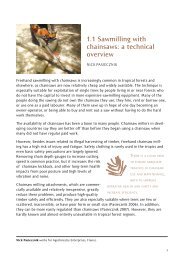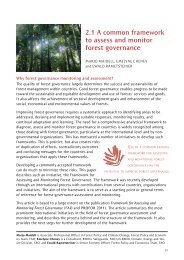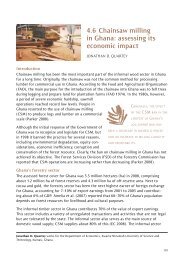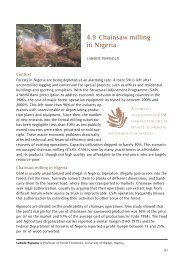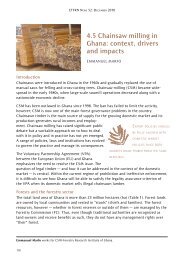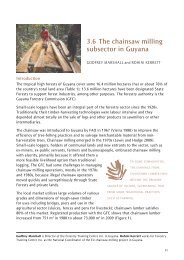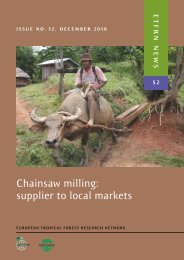Chainsaw milling: supplier to local markets - European Tropical ...
Chainsaw milling: supplier to local markets - European Tropical ...
Chainsaw milling: supplier to local markets - European Tropical ...
You also want an ePaper? Increase the reach of your titles
YUMPU automatically turns print PDFs into web optimized ePapers that Google loves.
2.5 FiNaNcial aNalysis oF small-scalE haRvEsTiNg iN papua NEw guiNEa<br />
cast. a 33% straightline annual depreciation was assumed for portable mills, chainsaws<br />
and winches (replaced every three years), with a 20% straightline depreciation for other<br />
capital equipment. miscellaneous costs of 20% of the <strong>to</strong>tal of marketing, administration,<br />
training and certification were assumed. returns and bad debts were assumed <strong>to</strong> be 5%.<br />
all purchases were assumed <strong>to</strong> be paid on receipt of goods and buyers were paid on<br />
delivery. Community enterprises do not pay individual or company tax.<br />
Results<br />
Exporting green sawn timber of higher value species and selling other species <strong>local</strong>ly<br />
(model b) was the most profitable option, earning pnGk 1.9 million over 20 years and<br />
with almost 15% return on sales (Table 2). it also had the shortest capital payback time<br />
(three years). model a (no value adding and sale of all products <strong>local</strong>ly) was moderately<br />
profitable (pnGk 0.6 million of accumulated profits over 20 years). start-up capital costs<br />
were the same as in (model b) but it <strong>to</strong>ok a year longer <strong>to</strong> pay them back.<br />
Table 2. comparison of four models for a portable sawmill (pNGk)<br />
financial criteria Model a Model B Model c Model D<br />
<strong>to</strong>tal profits, years 1–5 14,700 56,500 –507,000 69,600<br />
<strong>to</strong>tal profits, years 1–20 608,000 1,914,000 -3,183,000 429,000<br />
average return on sales 4.84% 14.86% –19% 2.4%<br />
start-up costs 780,000 780,000 1,800,000 1,800,000<br />
payback time of initial<br />
investment<br />
year 4 year 3 not possible year 5<br />
npV 20% 20% 20% 20%<br />
note: based on harvesting and processing of 1,000 m3 of log input per year and 50% sawn timber recovery from<br />
forests located 100 km from the point of sale in papua new Guinea. 1 pnG kina = us$0.37<br />
investing in adding value <strong>to</strong> the output from a single sawmill was not justified given the<br />
current prices for timber. model D — involving adding value and selling <strong>local</strong>ly — was less<br />
profitable than options a and b (pnGk 0.43 million over 20 years), with a lower return on<br />
sales (2.4%).<br />
model C (adding value through kiln drying, dressing and export of high-quality timber,<br />
with all other timber sold <strong>local</strong>ly as green material) was unprofitable (a loss of pnGk 3.2<br />
million over 20 years, and a 16.4% average loss on sales). it was not possible <strong>to</strong> pay back<br />
the starting capital in this option.<br />
To make value adding profitable, a significantly higher scale of production is required <strong>to</strong><br />
cover the high fixed and variable costs associated with operating a timber yard.<br />
Certification is a significant up-front cost that is currently not demanded by the <strong>local</strong><br />
market. if communities choose not <strong>to</strong> pay for certification, the profitability of model a,<br />
where all timber is sold <strong>local</strong>ly, would increase by 10% over the 20-year period.<br />
47



